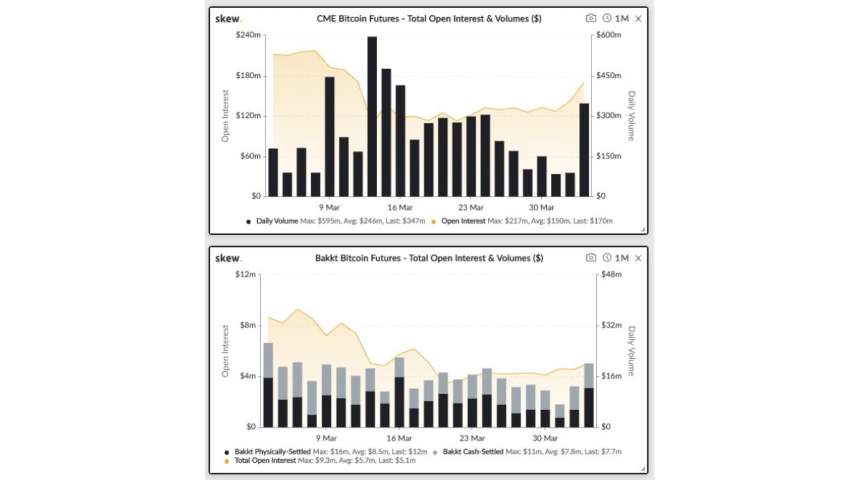Futures linked to the bitcoin market experienced a spike in their volumes this Thursday as the cryptocurrency’s spot rate broke above $7,000.
Crypto statist Skew highlighted that trading activity on CME’s and Bakkt’s bitcoin derivatives marketplaces surged by up to $595 million and $27 million, respectively. The move uphill left CME’s open interest as high as $217 million. On Bakkt, meanwhile, the value of outstanding futures contracts topped near $9.3 million.
“CME and Bakkt both with strong showings yesterday, the largest volume since Mar 16th,” tweeted Skew on Friday.

Return of Big Players to Bitcoin
Analysts treat Bitcoin Futures’ statistics as a gauge to measure institutional interest in the emerging Bitcoin industry. The higher the Open Interest gets, the more it confirms bitcoin as a matured asset class. It shows more and more people are betting on bitcoin’s future price.
While CME settles the bets in paper money, Bakkt offers to do the same via bitcoin. That creates real demand for the cryptocurrency.
Matt Hougan, the global head of research at crypto asset management firm Bitwise, treated the Thursday’s volume spike as a signal to bitcoin’s growing demand among big market players. He stated on the day:
“Today is the first day in a while that CME bitcoin futures volume has significantly exceeded Coinbase bitcoin trading volume, an early signal that institutions may be starting to look at crypto again.”
https://twitter.com/JohnTodaro1/status/1245789751262789632
Deflation
The statements appeared as the global economy continued to suffer losses amidst the fast-spreading Coronavirus pandemic. The US central bank and government earlier announced a plethora of stimulus packages to safeguard the economy, which includes a near-zero interest rate and a $2 trillion worth of cash injection.
Bulls for a long time have projected the economic aid as a slow poison for the US dollar. As the pandemic spreads, the greenback is likely to trend higher. But its over-supplied nature could cause massive inflation in the long run, a scenario that typically leads investors to put part of their money in deflationary assets, such as Gold.
The Fed's balance sheet exploded by $557.3 billion in the last week to $5.812 trillion. More shocking, money supply surged by $436.1 billion. In the past two weeks, the Fed's balance sheet is up by $1,143.4 trillion, fourteen months of QE3, and money supply is up $606.2 billion.
— Peter Schiff (@PeterSchiff) April 2, 2020
Bitcoin appears as an alternative to gold, the most typical risk-off hedging asset against fiat-induced inflation. The cryptocurrency has a limited supply cap of 21 million units. Speculators believe its growing demand could lead the price towards $100,000 per token in the coming years.
Weekly Federal Reserve Update: $550 billion printed this week. That's 5x annual gold production (before shutdown) or 4.5x the entire market cap of bitcoin. This isn't going to stop until political and economic leaders adopt a philosophy of money.
— Roy Sebag (@roysebag) April 3, 2020
The spikes in CME’s and Bakkt’s daily volume and open-interest somewhat proves that bitcoin’s safe-haven narrative is not dead. The cryptocurrency remains up by about 82 percent from its year-to-date bottom below $4,000. That shows there is adequate demand for it among investors who want to protect their fiat-enabled savings from central banks’ inflationary practices.
Since you are here… Take advantage of the trading opportunities with Plus500
Risk disclaimer: 76.4% of retail CFD accounts lose money.























